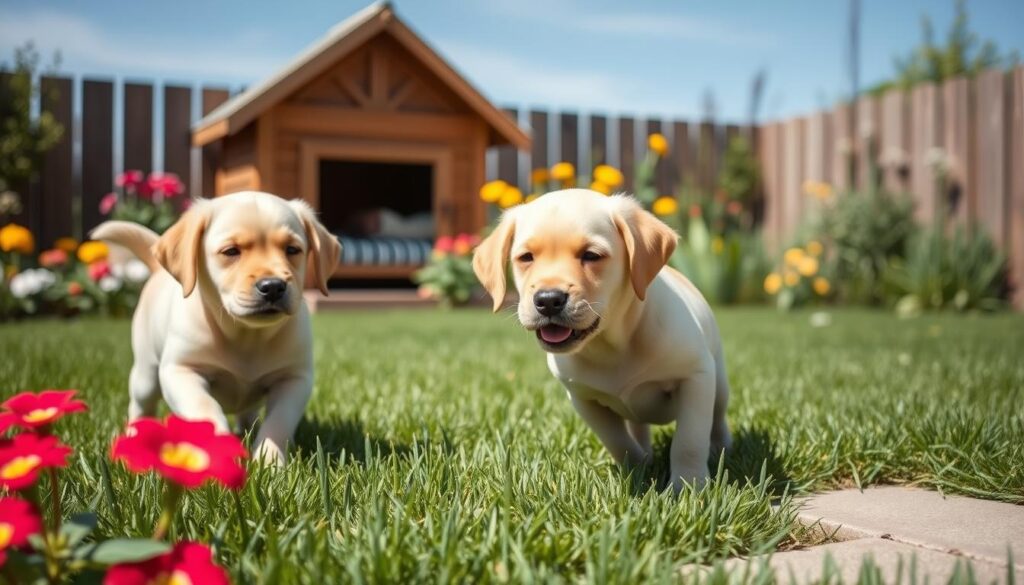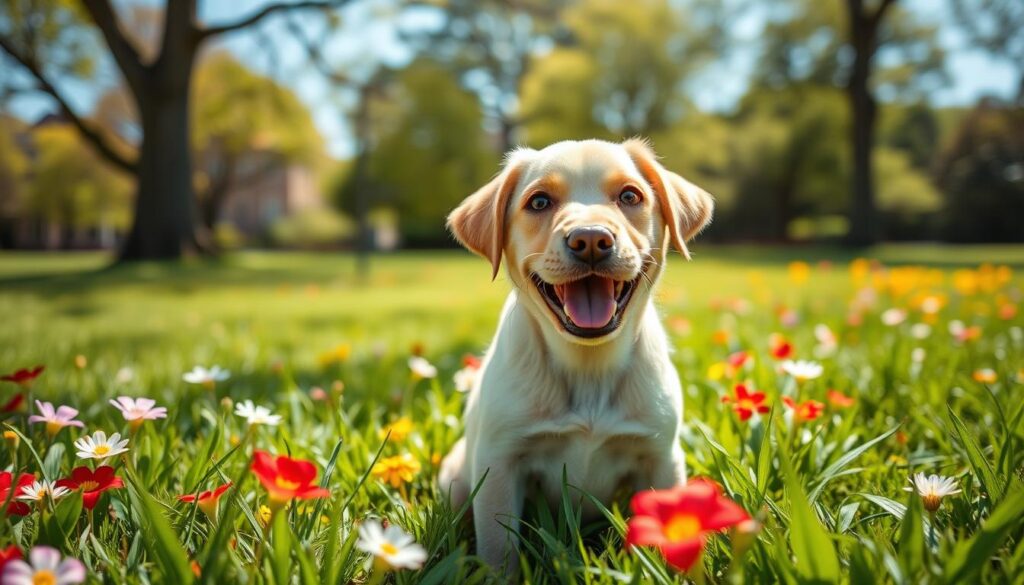What Is a Miniature Labrador Retriever? Everything You Need to Know
Imagine a playful, loyal friend with the classic Labrador Retriever look but smaller. That’s the miniature Labrador retriever. They have captured many hearts. As a miniature Lab owner, I know the joys and challenges they bring.
Though not officially recognized, these small dogs have a unique charm. It’s worth learning more about them.
Table of Contents
Understanding the Miniature Labrador Retriever Concept
The idea of a “miniature Labrador retriever” might catch your eye. But, it’s key to know the truth behind it. Miniature Labradors, or “mini labs,” aren’t a real breed to kennel clubs. They come from trying to make the standard Labrador retriever smaller.
Origins and Development
Labrador retrievers started in the 1800s for hunting and retrieving. Over time, different types like English and American Labs appeared. Breeders now aim for smaller sizes, but it’s not a new breed.
Common Misconceptions
Many think miniature Labradors are a real breed or healthier than big ones. But, these ideas aren’t true. They’re not a separate breed and can face health problems from being too small.
Reality vs. Marketing Claims
The term “miniature Labrador” is often used to sell dogs. Breeders say their smaller Labs are special. But, these dogs often come from bad breeding that ignores health and behavior.
Knowing the real deal about miniature Labradors is important before getting one. Their small size might look good, but their health should come first.
The Truth About Small-Sized Labradors
Small-sized Labradors are not a recognized breed. They come from natural genetic variations or selective breeding. This is not a distinct dog variety.
These small Labradors have the same loving nature as the standard size. But, owners should know about health risks from breeding them small. This practice raises ethical questions in the dog community.
To understand small Labradors, let’s look at their origins and the truth behind them.
Origins and Development
Small Labradors can be the “runts” of a litter, naturally smaller. Breeders have bred these smaller dogs to make a “lap-sized” version of the Labrador.
But, many criticize this practice. They say it may cause health issues and goes against the breed standard. Responsible breeders focus on the animal’s health, not just size.
Misconceptions and Reality
Small Labradors are not a separate breed. They are just Labrador Retrievers that are smaller, due to genetics or selective breeding.
These smaller Labradors might face health risks like joint or breathing problems. Owners should research and talk to vets before getting one.
In conclusion, small Labradors can be great pets. But, owners need to understand the challenges and ethics involved. By focusing on the animal’s health, we can have a happy and healthy relationship with them.
Genetic Dwarfism in Labradors
Genetic dwarfism is a big worry for Labrador Retrievers. It’s caused by two genes: SD1 and SD2. Knowing about these genes helps us take care of Labradors better.
SD1 Gene (Osteochondrodysplasia)
The SD1 gene causes dwarfism in Labradors. It leads to bent legs and bad bones. This can cause serious health problems like joint issues and breathing trouble. Dogs with SD1 often live shorter lives.
SD2 Gene (Skeletal Dysplasia)
The SD2 gene causes a different kind of dwarfism. It makes legs shorter but keeps the body normal size. While not as bad as SD1, SD2 can still cause health problems.
Impact on Health and Development
Genetic dwarfism affects Labradors a lot. Both SD1 and SD2 can lead to joint issues, breathing problems, and shorter lives. It’s important for owners and breeders to know about these genes.
Testing for these genes helps breeders avoid dwarf Labradors. This way, we can keep Labradors healthy and happy. They can stay our beloved pets and working dogs.
“Genetic dwarfism is a significant challenge in Labrador Retrievers, but with proper testing and responsible breeding practices, we can work to minimize the impact of this condition on the breed.”
Methods of Creating Smaller Labs
Many people want a smaller Labrador Retriever. This has led to the creation of “mini” Labs. But, the ways to make these smaller dogs are often debated. They might not be good for the dog’s health.
There are three main ways breeders make miniature Labradors:
- Crossbreeding with Smaller Breeds: Breeders mix Labradors with smaller dogs like Cocker Spaniels or Poodles. This makes a dog that’s smaller, but it’s not a purebred Labrador anymore. It’s a mix.
- Breeding Dogs Carrying Dwarfism Genes: Some breeders use genetic dwarfism to make smaller Labradors. But, this can cause serious health problems. Dogs might have bad legs, joint issues, and breathing problems.
- Selectively Breeding Runts: Some try to make smaller Labradors by picking the smallest puppies. This is seen as wrong and can harm the puppies’ health. The small size might mean the puppy is sick or didn’t get enough to eat.
These ways to make smaller Labradors are not approved by good breeders or kennel clubs. They care more about the dog’s health than its size. Real Labrador breeders aim to keep the breed healthy, active, and true to its standard.

“Miniature Labrador Retrievers typically weigh between 30 to 50 pounds and stand about 12 to 18 inches tall, significantly smaller than their full-sized counterparts.”
Even though a smaller Labrador might seem nice, it’s important to know the risks. It’s crucial for Labrador owners and those looking to buy one to be careful. Avoid breeders who promise “teacup,” “micro,” or “miniature” Labradors. They might be using tricks to sell dogs.
Physical Characteristics and Size Comparison
Miniature Labrador Retrievers are smaller than the standard ones. They usually stand between 17 to 22 inches tall and weigh 35 to 50 pounds. Standard Labradors, on the other hand, are taller, standing 21 to 24 inches, and heavier, weighing 55 to 80 pounds.
Height and Weight Standards
Miniature Labradors have a strong build and look like Labradors but are smaller. They have a muscular body, an otter-like tail, and a thick coat. Their size difference is mainly in height and weight, with Miniature Labs being smaller.
Appearance Features
Miniature Labradors are smaller, which makes them look a bit more rounded or “toy-like” than standard Labradors. Yet, they still have the same broad head, floppy ears, and a friendly face.
Coat Types and Colors
Miniature Labradors have the same coat types and colors as standard Labradors. Their coats can be black, yellow, or chocolate. They also have a dense, water-resistant double coat. Despite their size, Miniature Labs look just as good as standard Labradors.
| Characteristic | Standard Labrador Retriever | Miniature Labrador Retriever |
|---|---|---|
| Height | 21-24 inches | 17-22 inches |
| Weight | 55-80 pounds | 35-50 pounds |
| Lifespan | 11-13 years | 11-13 years |
| Coat Colors | Yellow, Chocolate, Black | Yellow, Chocolate, Black |
Health Concerns and Life Expectancy
Miniature Labrador Retrievers are delightful companions but may have health issues due to their size. They can suffer from joint problems, breathing issues, and spinal issues. Common health problems include hip dysplasia, back disease, and obesity, which can shorten their life.
These small dogs usually live shorter lives than standard Labradors. They can live between 7 to 10 years, while standard Labs live up to 12 years. Their shorter lifespan is due to their smaller size and genetic differences.
It’s vital to take your miniature Labrador to the vet regularly. Owners should watch their pet’s weight, make sure they get enough exercise, and feed them a balanced diet. This care helps these small dogs live longer, happier lives.
“Miniature Labradors may face a shorter lifespan, but with the right care and attention, they can thrive and bring boundless joy to their families.”
While their small size is charming, it’s important to know about health issues. These can affect their lifespan. By understanding these concerns and providing the right care, owners can make sure their miniature Lab has a happy, full life.

Training and Exercise Requirements
Miniature Labrador Retrievers are smart and easy to train, just like their bigger friends. They need lots of physical activity and mental games to be happy and healthy.
Physical Activity Needs
Mini Labs don’t need as much exercise as big Labs, but they still need a lot. Try to give them 30-60 minutes of playtime each day. This can be walks, fetch, or just playing around.
Keeping them active helps them stay at a good weight and prevents bad behavior from boredom.
Mental Stimulation
Mini Labradors also love to use their brains. Give them toys that challenge them, teach them tricks, and solve puzzles. Training keeps their minds sharp and stops them from getting into trouble.
By keeping their minds busy, you’ll make sure they’re happy and well-adjusted.
Socialization Tips
Socializing your mini Labrador early is key. Introduce them to lots of people, animals, and places. This helps them grow up to be friendly and outgoing.
Positive experiences when they’re young will make them confident and friendly. This is important for their development.
Even though they’re smaller, mini Labradors need the same care and attention as big ones. Meeting their needs will make them a loving part of your family.
Choosing a Responsible Breeder
When looking for a miniature Labrador, picking a good breeder is key. Good breeders focus on their dogs’ health, not just their size. They avoid terms like “teacup” or “micro” Lab.
They should offer health clearances and be open about their breeding methods. They also join breed-specific groups or dog sports.
Great breeders know how important socialization is. They wait until puppies are 8-12 weeks old before they go to new homes. This lets them grow and adjust to new places and experiences.
They can tell you about the health and behavior of their dogs’ parents. They also give a health guarantee and a contract that shows their commitment to their puppies.
Adopting a Labrador from a shelter or rescue is a smart choice too. These dogs are often well-socialized and may have already had medical care and training. By choosing a responsible breeder or adopting, you help ensure your new pet has a great start in life.







